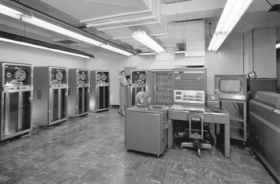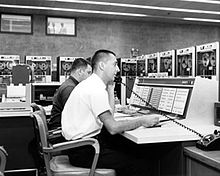IBM 700/7000 series
The IBM 700/7000 series was a group of several mainframes made by IBM . They were offered in the 1950s and early 1960s. The individual computers in the IBM 700/7000 series had different, incompatible architectures .
Architectures
The IBM 700/7000 series consisted of very different computers. Depending on the storage of the data and the instructions, these can be classified as follows:
- First calculator (36/18 bit words ): 701 (Defense Calculator)
- Scientific (36-bit words): 704 , 709 , 7090 , 7094 , 7040 , 7044
- Commercial (variable length of the character strings ): 702 , 705 , 7080
- 1400 series (variable length of the character strings): 7010
- Decimal (10 digits ): 7070 , 7072 , 7074
- Supercomputer (64-bit words): 7030 "Stretch"
The 700 class used vacuum tubes , the 7000 class transistors . The early IBM 701 and IBM 702 still used Williams tubes . The IBM 7070, the transistorized successor to the IBM 650 , was a decimal calculator . Data and addresses were shown in decimal form.
software
In the early days of computers, computers were delivered without software. When operating systems emerged, this was problematic with the IBM 700/7000 series. Due to the different architectures, programs had to be created several times. The System / 360 took a different approach in this regard. The System / 360 inherited the best aspects of the IBM 700/7000 series architectures, but had only a single architecture.
The first architecture (IBM 701)
The calculator is also known as the Defense Calculator and was introduced in 1953. The data format was either 36 bits or 18 bits long, only as a fixed point number . The instructions were 18 bits long, with a total of 32 instructions. The main memory consisted of 2,048 and 4,096 36-bit words, respectively, with a character having 6 bits.


